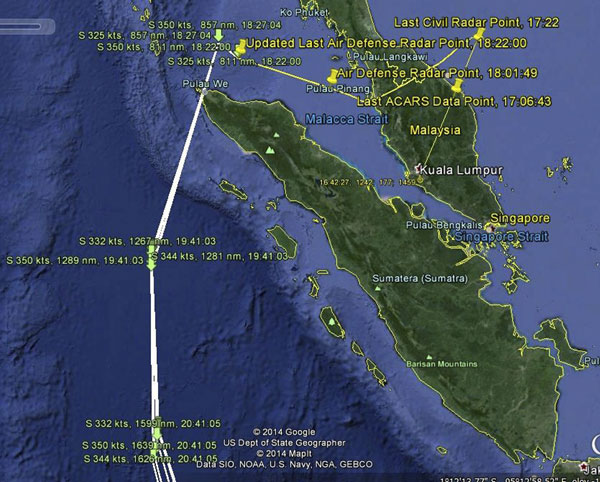One year later: Benefits from the search for MH370
Updated: 2015-03-06 14:28
(Agencies)
|
||||||||
 |
|
A map shows the possible path of Malaysia Airlines flight MH370 as released by the Malaysian Transport Ministry May 1, 2014.[Photo/Agencies] |
Better plane tracking
One thing the airline industry learned from Flight 370 is that more tracking is needed, even for planes expected to fly over land for their entire journeys.
The International Civil Aviation Organization, which is part of the United Nations, has proposed that airlines be required to get position updates from each of their planes every 15 minutes. That requirement is expected to be in place by November 2016.
A more stringent requirement would seek updates every minute if a fire is detected or the plane makes an unusual move, such as suddenly dropping or climbing in elevation. That would apply only to jets manufactured after 2020.
Australian Transport Minister Warren Truss said Sunday that his government's airspace agency will work with Malaysia and Indonesia to test a new method, which would enable planes to be tracked every 15 minutes, rather than the previous rate of 30 to 40 minutes. However, even if such a system had been in place for Flight 370, it would not have made it possible to track the plane because transponder and other equipment were switched off.
Because investigators still don't know what happened to Flight 370, airlines have no information to help them update their mechanical systems or flight-training techniques.

 Culture Insider: 6 things you may not know about Awakening of Insects
Culture Insider: 6 things you may not know about Awakening of Insects
 Top 10 favorite gift brands of rich Chinese men
Top 10 favorite gift brands of rich Chinese men
 Buddha statue with mummified monk is museum draw
Buddha statue with mummified monk is museum draw
 Snowstorm rages in eastern US
Snowstorm rages in eastern US
 Across Canada March 4
Across Canada March 4
 Seven things you may not know about Lantern Festival
Seven things you may not know about Lantern Festival
 Top 10 destinations for Chinese tourists
Top 10 destinations for Chinese tourists
 Floods displace over 2,000 in Brazil
Floods displace over 2,000 in Brazil
Most Viewed
Editor's Picks

|

|

|

|

|

|
Today's Top News
US fails to grasp China's terror laws: legislature
Militaries' cooperation 'key' in ties
China, California address climate, energy issues
US companies bullish on China
China faces 'formidable challenges', says Li
Diplomats talk about 'two sessions'
GDP target drops to 7%
US ambassador to S.Korea attacked
US Weekly

|

|







